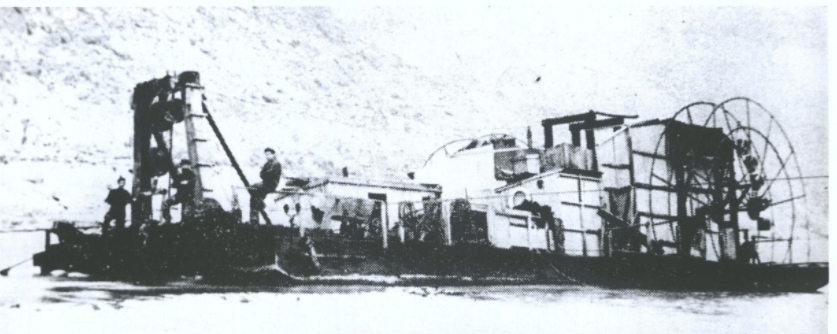In the Current-wheel Dredge, the mechanism on these dredges is driven by an under-shot water-wheel, placed at one or at both sides of the scow and rotated by the current. Such dredges work with most safety and regularity in about a 3-knot current.
An instance of a machine of this kind is the Mannherikia dredge, working, in 1894, on the Clutha. The boat was 60 ft. long, with 22 ft. beam. The estimated output was 30 tons of wash-dirt per hour, and the labour one man per shift. The sluicing water was raised in small buckets attached to the rim of the current wheels. In the part of the river operated on, the stream was very rapid from side to side, and enabled the dredge to do all that a steam machine could and at much lower cost.
L. Gard’s No. 2 dredge, on the same river, was 78 ft. long, 20 ft. beam, and 5 ft. draught. It dredged to 27 ft., lifted from 35 to 40 tons per hour, and employed generally one man per shift. The sluicing water was raised by buckets, as above. The average cost of working was £14 per week.
In the Victoria dredge, Alexandra, the current wheel was 22 ft. in diameter, and was estimated to develop 15 h.-p. on a 5 to 6-mile per hour current. There were 14 floats on each wheel, which revolved seven times per minute. The buckets were calculated to hold 2 cubic ft., and to discharge at the rate of 11 buckets per minute, delivering 48 cubic yards per hour.
The advantages of current-wheelers over steam or electric dredges are:
- Small first cost;
- natural motive power;
- low labour charges.
Their disadvantages are:
- Unsteady work;
- dependence on a strong current for power;
- necessity of obtaining current by working well out in the stream, where, during a considerable part of the year, the water may be too deep, or the deposit of silt too great to permit of continuous work;
- liability of the current being checked or diverted by the tailings piled up by the dredge.
- Finally, their inability to work near the beaches and eddies, where current is wanting, but where the richest portions of wash-dirt are generally formed.
